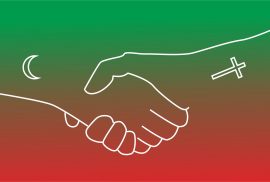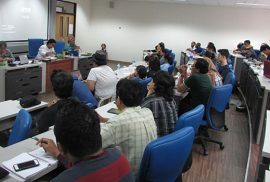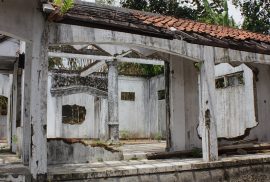Azis Anwar Fachrudin | CRCS | Article
In two consecutive days of this week, the world’s two biggest religions commemorate the birth of their respective “founders”: Islam’s Prophet Muhammad (Maulid) and Christianity’s Jesus Christ (Christmas). This is certainly a rare event that will not happen for dozens of years to come.
In Indonesia, both commemorations have officially been declared national holidays. Indonesia is among most Muslim-majority countries in which Maulid constitutes a national public holiday. It is only in Saudi Arabia and Qatar, out of all Muslim majority countries, where Maulid is not a holiday, probably because of the views of clerics there who regard Maulid celebration as Islamically illegitimate and bid’ah (heretical). Besides, Indonesia is among several Muslim-majority countries that recognize Christmas as a national holiday.
This is a momentous time for both Muslims and Christians to reinforce interfaith dialogue — it probably could be incorporated in the agenda of the commemorations.
For Indonesians in particular, it is worth being grateful that the annually held debate among people at the grassroots — on whether saying “Merry Christmas” to Christians is religiously allowed for Muslims — is coming to an end. Additionally, another annual debate on whether Muslims may celebrate Maulid has generally begun decreasing.
In fact, these two debates on Maulid and Christmas are mostly fueled by Wahhabist views. Across the Muslim world, it is mostly the Wahhabists who claim that saying “Merry Christmas” is tantamount to affirming Christian belief on Jesus’ divinity and as such forbidden.
And why is the debate now not as heated as in the previous years? I heard a satirical comment in social media saying that it is because the Wahhabists are nowadays preoccupied with declaring the Shiites infidels. A plausible explanation! The sense of “feeling threatened” has now been shifted from Christians to Shiites, as well as to communists (whose political party no longer exists).
As for interreligious dialogue, now is a good time to recall and to remind Muslims and Christians of the document, A Common Word Between Us and You, which was launched in 2007. Originally an open letter to the Catholic pope, it has now been signed by hundreds of the world’s leading Muslim scholars and intellectuals (it can be accessed at acommonword.com). The document basically conveys that there are more common grounds for peace between Muslims and Christians than conflicting teachings. The document was then responded to by Loving God and Neighbor Together: A Christian Response to A Common Word, which was initially signed by more than 300 Christian leaders and scholars.
These kinds of documents should be more endorsed by respective leaders, clerics and scholars, for at least two reasons. First because, particularly in Indonesia, the document seems to be less exposed to the public. Second, nowadays we see a rising intolerance in the respective worlds. The rise of Islamophobia in the West, not only in Europe but also in the US given the recent phenomenon of presidential hopeful Donald Trump, is a good example.
On the other side, the Muslim world is now suffering from radicalization, resulting in the emergence of the Islamic State (IS) movement. This is why peace-building and tolerance activists should work harder to win the discourse in the respective worlds, including for example by exposing their respective communities to the documents.
As for the Muslim world, the Maulid commemoration can be a good time to reread the Prophet’s biography, not only to praise or glorify him but also to deal with how we should understand his having been a leader of wars in today’s context. Around the globe, Muslims usually celebrate Maulid by reciting salawat (prayers) or madah nabawi (a kind of eulogy to praise the prophet). In Indonesia particularly, Muslims recite books containing Arabic poetry of salawat or madah nabawi.
I think that in today’s context such a reading of the Prophet’s biography, while good, should be furthered with rereading about the violence surrounding his life. This is important because some Muslims who do violence nowadays quite often justify their acts by citing examples of the violence commanded by the prophet.
Prophet Muhammad, unlike Jesus, was a leader in war. He was involved in nine wars. Furthermore, he dispatched military expeditions at least 38 times. Some early biographers of the Prophet emphasized this aspect; this is why their books were entitled Maghazi (literally “wars”) and it became a genre of biography at the time. All these wars left hundreds of victims and happened during eight years from 2 AH to 9 AH, a period in the last phase of Muhammad’s prophetic ministry when Muslims became quite powerful.
How then should today’s Muslims read those wars led by the Prophet? This has very much to do with Islamic jus ad bellum, especially on what circumstances violence can be justified under Islamic teachings. Rereading these, I think, is more important as a counter interpretation of violent Muslims rather than saying normatively that “Islam is a religion of peace” or that “rahmatan lil-‘alamin” (“the prophet was sent as a mercy for all creatures”).
Headline
Subandri Simbolon | CRCS | News
Kepala Program Studi CRCS UGM, Dr. Zainal Abidin Bagir, meraih Penghargaan Insan Berprestasi UGM 2015 untuk kategori “Publikasi dengan Sitasi Terbaik.” Rektor UGM, Prof. Ir. Dwikorita Karnawati memberikan penghargaan kepada 160 insan terpilih dari 10 kategori dalam malam penganugerahan pada perayaan Dies Natalis UGM, Rabu, 16 Desember 2015. Prof. Dwikorita mengatakan, tujuan acara ini adalah sebagai apresiasi atas capaian dan prestasi yang diraih para sivitas akademika dan alumni UGM..
 Penilaian atas kategori “Publikasi dengan Sitasi terbaik” ini dilakukan oleh tim penilai yang ditunjuk oleh Lembaga Penelitian dan Pengabdian Masyarakat (LPPM) UGM. Pelaksanaan penilaian dilakukan dengan memilih artikel yang tercatat pada Scopus dengan jumlah sitasi terbanyak selama 4 tahun terakhir. Selain itu artikel harus ditulis oleh dosen tetap UGM dengan mencantumkan nama UGM sebagai institusi kerjanya. Dalam kurun dua tahun terakhir, Dr. Zainal Abidin Bagir telah mempublikasikan 12 tulisan di jurnal nasional maupun internasional.
Penilaian atas kategori “Publikasi dengan Sitasi terbaik” ini dilakukan oleh tim penilai yang ditunjuk oleh Lembaga Penelitian dan Pengabdian Masyarakat (LPPM) UGM. Pelaksanaan penilaian dilakukan dengan memilih artikel yang tercatat pada Scopus dengan jumlah sitasi terbanyak selama 4 tahun terakhir. Selain itu artikel harus ditulis oleh dosen tetap UGM dengan mencantumkan nama UGM sebagai institusi kerjanya. Dalam kurun dua tahun terakhir, Dr. Zainal Abidin Bagir telah mempublikasikan 12 tulisan di jurnal nasional maupun internasional.
Saat dijumpai di kantor CRCS UGM, pria yang akrab dipanggil Pak Zein ini mengaku tidak mengetahui perihal pemilihan tersebut. Bahkan, dosen pengampu mata kuliah Religion, Science, and Ecology ini cukup terkejut ketika dihubungi untuk menghadiri malam penganugerahan. Namun, ia senang atas apresiasi yang diberikan oleh Universitas Gadjah Mada.
Sebagai insan terbaik dalam kategori “Publikasi dengan Sitasi Terbaik”, Dr. Zainal memiliki pesan khusus untuk publik, “Kita sadar di Indonesia ini agak susah untuk urusan menulis, tetapi itu harus. Dengan segala keterbatasan, penting untuk selalu mencari dan mencuri waktu. Di Indonesia, kalau dibandingkan dengan banyak universitas lain di luar negeri, dosen sering kali terlalu banyak dibebani dengan tugas yang macam-macam termasuk tugas administratif yang menghabiskan waktu untuk menulis. Untuk universitas-universitas, para insan akademis perlu di-support supaya ada waktu untuk menulis.”
A. S. Sudjatna | CRCS | News
Agama tidak perlu dibela. Yang perlu dibela adalah inti dari agama: keadilan dan kebenaran. Kurang lebih seperti itulah hal yang diungkapkan oleh Elga Sarapung di awal pemaparannya dalam diskusi bertema “Atas Nama Agama? Sebuah Tinjauan atas Kekerasan di Singkil dan Tolikara”, Jumat, 11 Desember 2015. Diskusi ini menampilkan dua orang pembicara, Elga Sarapung dari Interfidei dan Rizal Panggabean, staf pengajar di Departemen Hubungan International, UGM.
Diskusi yang diselenggarakan oleh Institute of International Studies (IIS), Jurusan Ilmu Hubungan International, Fakultas Fisipol, UGM, ini merupakan sebuah refleksi atas peringatan hari HAM (Hak Asasi Manusia) sedunia yang jatuh tiap tanggal 10 Desember. Diharapkan, dengan adanya diskusi ini para mahasiswa dan kalangan akademisi lainnya dapat memahami secara lebih komprehensif dua kasus kekerasan atas nama agama yang belum lama ini terjadi di ujung barat dan timur wilayah Indonesia. Diskusi ini berlangsung selama sekitar dua jam setengah dan dihadiri oleh lebih dari lima puluh peserta dari kalangan akademisi dari berbagai fakultas.
 Dalam diskusi yang dimoderatori Ayu Diasti Rahmawati—staf pengajar departemen HI UGM—ini, Elga menyampaikan kekerasan yang terjadi di Tolikara, Papua, maupun kekerasan yang terjadi di Singkil, Aceh, memang tak lepas dari faktor agama. Pernyataannya tersebut didasarkan pada berbagai fakta yang ia temukan di lapangan. Menurutnya, ada intoleransi di dalam kedua kasus tersebut. Oleh sebab itu, menurut Elga, kita tidak boleh selalu memandang agama sebagai faktor yang tidak mungkin menjadi sumber terjadinya tindak kekerasan. “Jangan takut untuk mengkritik agama,” tegasnya.
Dalam diskusi yang dimoderatori Ayu Diasti Rahmawati—staf pengajar departemen HI UGM—ini, Elga menyampaikan kekerasan yang terjadi di Tolikara, Papua, maupun kekerasan yang terjadi di Singkil, Aceh, memang tak lepas dari faktor agama. Pernyataannya tersebut didasarkan pada berbagai fakta yang ia temukan di lapangan. Menurutnya, ada intoleransi di dalam kedua kasus tersebut. Oleh sebab itu, menurut Elga, kita tidak boleh selalu memandang agama sebagai faktor yang tidak mungkin menjadi sumber terjadinya tindak kekerasan. “Jangan takut untuk mengkritik agama,” tegasnya.
Untuk menguatkan pernyataannya tersebut, Elga menunjukkan beberapa argumen. Ia menyebutkan bahwa sikap intoleran yang ditunjukkan oleh GIDI dengan membuat surat edaran yang melarang umat Islam mengadakan perayaan Idul Fitri sangatlah jelas. Bahkan, sikap intoleran GIDI tersebut tidak hanya ditujukan terhadap komunitas yang berbeda agama, melainkan juga terhadap sesama Kristen, seperti yang mereka lakukan terhadap umat Advent. Dalam hal ini, Elga juga mengutip ucapan Ustadz Ali Muchtar saat acara peletakan batu pertama pembangunan kembali masjid di Tolikara, “Saya tidak bisa tidur semalam. Kenapa GIDI tidak diundang dalam acara ini? Yang kami butuhkan adalah pengakuan dari warga GIDI.” Menurut Elga, ucapan Ustadz Ali Muchtar ini menunjukkan kemungkinan adanya sikap-sikap intoleran yang dialami oleh mereka selama ini.
Oleh sebab itu, menurut Elga, faktor agama dalam kasus Tolikara ini sangat kuat. Begitu pula dengan kasus di Singkil, Aceh. Elga menunjukkan bagaimana tekanan umat Islam terhadap minoritas Kristen yang ada di sana begitu kentara. Hal ini terlihat dalam perjanjian yang terjadi di antara kelompok umat Islam dan Kristen mengenai pembatasan jumlah gereja yang boleh dibangun. Menurut Elga, perjanjian mengenai pembatasan jumlah gereja yang terjadi sejak 1979 dan diperbarui pada 2001 tidaklah logis. Sebab, dalam kurun waktu selama itu, jumlah umat Kristen dan luas wilayah yang dihuni oleh mereka pastilah bertambah. Konsekuansinya, penambahan jumlah gereja sangat dibutuhkan. Selain itu, sebagaimana ditambahkan oleh Rizal, adanya keterlibatan organisasi Islam dalam mobilisasi massa pada kasus Singkil semakin menunjukkan peran agama dalam soal tindak kekerasan ini.
Berdasarkan bukti-bukti tersebut dan beberapa fakta lainnya yang ditemukan di lapangan, Elga berkesimpulan bahwa memang agama memainkan peran yang sangat penting di dalam dua kasus kekerasan tersebut. Meskipun demikian, baik Elga maupun Rizal tidak menampik adanya faktor lain yang dapat mengeskalasi kedua konflik tersebut, misalnya faktor ekonomi dan kekuasaan. Dalam hal ini, Rizal mengungkapkan bahwa kemungkinan adanya kecemburuan sosial antara warga asli dan pendatang di Singkil sangat besar. Sebab, menurut Rizal, kebun sawit di Singkil banyak dimiliki oleh para pendatang dari Tapanuli yang kebanyakan dari mereka beragama Kristen. Adanya kecemburuan sosial pendatang-pribumi ini tentu saja tidak dapat dilepaskan dari program transmigrasi oleh pemerintah. Begitu pula, denominasi gereja baru yang banyak bermunculan di Papua tidak menutup kemungkinan bagi hadirnya konflik antara maupun antar-agama di sana.
Selain menyingung banyak soal peranan agama pada—khususnya—kedua kasus kekerasan tersebut, baik Elga maupun Rizal juga sama-sama menyoroti peran pemerintah dan aparat keamanan. Keduanya menganggap bahwa pemeritah—yang direpresentasikan oleh aparat keamanan—memiliki andil yang cukup besar dalam proses terjadinya dua kekerasan tersebut. Dalam hal ini, Elga mencontohkan bahwa saat para pemuda GIDI hendak menegur pihak umat Islam saat melakukan salat Idul Fitri di lapangan yang terhalang oleh landasan pesawat, seharusnya aparat keamanan bisa mengantisipasinya. Sebab, menurut Elga, tidak mungkin para pemuda GIDI tersebut dapat lolos dari pantauan petugas keamanan saat menyeberangi landasan pesawat menuju lokasi shalat Idul Fitri. Begitu juga pada kasus Singkil, seharusnya aparat dapat mengantisipasi kejadian pembakaran gereja sebab isu tersebut sudah muncul dan makin menguat beberapa hari sebelumnya. Contoh lain, misalnya, kasus Syiah di Sampang menunjukkan betapa aparat negara terlibat secara langsung dalam proses terjadinya kekerasan. Ada salah seorang aparat negara yang secara terbuka memprovokasi masyarakat untuk melakukan tindakan intoleran terhadap kelompok Syiah. Namun, pada semua kasus tersebut, negara belum mampu bersikap tegas dan cepat tanggap dalam penegakan hukum.
Sebagai konklusi dari acara diskusi ini, setidaknya ada lima hal yang perlu dilakukan untuk meredam atau menangani kasus kekerasan atas nama agama. Pertama, mencari akar masalah pencetus terjadinya kekerasan. Dalam hal ini termasuk melihat kembali pemahaman seseorang atau sekelompok orang tentang agamanya serta implementasinya. Hal ini penting sebab agama memiliki pengaruh amat signifikan terhadap pengambilan sikap dan keputusan seseorang. Kedua, melakukan pengelolaan perbedaan dengan sungguh-sungguh. Hal ini dapat dilakukan oleh setiap pribadi maupun kelompok agama. Ketiga, melakukan solidaritas konstruktif, bukan destruktif. Misalnya, saat terjadi kekerasan terhadap sebuah kelompok di suatu wilayah, maka kelompok yang sama di wilayah lain seyogianya tidak melakukan balas dendam terhadap rival kelompoknya yang ada di wilayah mereka. Keempat, negara harus kuat, tegas, jelas, dan adil dalam penegakan hukum bagi setiap kasus tindakan kekerasan atas nama agama. Kelima, pemimpin negara dan para tokoh agama harus solid baik dalam ucapan mapun tindakan konkret dalam menjaga toleransi agama. Selain kelima hal itu, hadirnya aspek norma dan perilaku serta aspek kelembagaan dalam proses mewujudkan toleransi beragama sangatlah penting.
Azis Anwar Fachrudin | CRCS | Article
Is it possible and necessary to have voices from Islam that are both against and for a moratorium on the death penalty? I think it is necessary, as what shapes discourse in the Muslim communities of Muslim-majority countries can influence policies in those countries. In Indonesia, for instance, an interpretation of sharia promoting a moratorium on the death penalty has been raised, but it is unfavorable to many Muslim scholars.
 Amid the uproar concerning the death penalty for Indonesian migrant workers in Saudi Arabia, as well as that of drug convicts in Indonesia, opposing voices in the name of Islam are barely heard. Nahdlatul Ulama (NU), the largest Muslim organization in Indonesia, considered moderate by many, condemned the death penalty for migrant workers in Saudi Arabia, yet supported the death penalty for drug convicts. But in general, the death penalty is a non-issue for Islamic organizations.
Amid the uproar concerning the death penalty for Indonesian migrant workers in Saudi Arabia, as well as that of drug convicts in Indonesia, opposing voices in the name of Islam are barely heard. Nahdlatul Ulama (NU), the largest Muslim organization in Indonesia, considered moderate by many, condemned the death penalty for migrant workers in Saudi Arabia, yet supported the death penalty for drug convicts. But in general, the death penalty is a non-issue for Islamic organizations.
First, this is maybe because death penalty cases in general scarcely touch the issue of Muslim identity politics — many so-called secular Muslims are on both sides of the debate. Second, capital punishment, along with corporal punishment, is prescribed in Islamic scripture so it is very difficult, though not impossible, to have a voice of Islam that is against the death penalty.
However, 21st century Muslims should review the practices of the death penalty in Muslim-majority countries and this can be done even within the realm of Islamic teachings or sharia. Here are the premises.
Sharia by many Muslims nowadays is reductively understood in terms of legalistic formulae. Sharia is associated with corporal and/or capital punishment, as if sharia is nothing but a penal code and punishments. Yet sharia literally means the way or path. In Koranic terminology, it means the path toward an objective representative of the supreme virtue of Islam, which is justice (some would add dignity of human beings and mercy and love for all creatures).
Muslim scholars, ranging from reformists, rationalists, even literalists, would agree that the supreme value promoted by Islam when it comes to dealing with relationships among individuals and/or communities is justice, as explicitly stated and commanded by God many times in the Koran. The mercy that Islam would bring to the world is justice.
Any action leading to injustice, in whatever name, including in the name of Islam, is therefore un-Islamic and should be opposed by Muslims. All Islamic legal opinions that are against justice are thus against the sharia of Islam.
As God has commanded Muslims to be “bearers of witness with justice”, as the Koran states, Muslims should share the notion once voiced by Martin Luther King Jr. that “injustice anywhere is a threat to justice everywhere”. All unjust punishments should be an Islamic issue, including questions over the death penalty of Indonesian migrant workers and foreign and local drug convicts.
Now, the question is how justice is manifested in punishment. The traditional fiqh (Islamic law and jurisprudence) is still lacking discussion of the philosophy of justice compared to advanced discourse in the secular realm, which has led to the concept of restorative justice, distinguished from retributive justice. The idea of qisas (an eye for an eye) is mostly understood as a deterrent and/or equal retaliation within retributive justice.
Nevertheless, Muslim scholars advocating a moratorium on the death penalty are echoing these arguments: corporal punishment, stoning or the death penalty cannot be implemented within an unjust system of governance, judiciary, or an unequal society, given the fact that those punishments are irreversible.
In this view, a just system is a prerequisite of such irreversible punishments. An unjust system is considered one of the shubuhat (ambiguities) based upon which the irreversible punishment must not be applied, as the Prophet Muhammad said. Included in that unjust system are dictatorships that are still embraced by many Muslim-majority countries, where the weak and poor are more likely to be punished than the wealthy and powerful.
That is the argument posed by some NU leaders in criticizing Saudi Arabia’s death penalty for Indonesian migrant workers, given frequent reports of torture and other dehumanizing practices by employers.
With regard to restorative justice, Mutaz M. Qafisheh from Hebron University in the International Journal of Criminal Justice Sciences wrote that Islamic jurisprudence had many alternatives to original punishments known in modern restorative justice systems, such as compensation (diya), conciliation (sulh) and pardon (afw). These mechanisms are stated in the Koran and were exemplified by the Prophet. Qafisheh also says that classical Muslim scholars had unique mechanisms derived from the wider principles of Islam that can be understood as restorative means, such as repentance (tawba), intercession (shafaa), surety (kafala) and expiation (kafara).
He concludes: “By looking at the philosophy of penalty as detailed by Islamic jurisprudence […] restorative justice does exist. It exists as the general rule. Retributive justice is the exception.”
That kind of reinterpreting of Islamic scripture should be advanced by today’s Muslim scholars if Muslims want to be able to respond to the discourse of international human rights.
Also, for the Muslims who are so obsessed with the rules textually prescribed in the scripture, we should consider the notion that God’s revelation is not only in the text (ayat qauliyyah) but exists also in the universe (ayat kauniyyah), in the way human beings behave. Modern sociology and criminology should be juxtaposed and mirrored with traditional fiqh by Muslim jurists in their interpretations of the scripture.
Fardan Mahmudatul Imamah | CRCS | SPK
Setelah mengalami berbagai tekanan dari negara maupun kelompok intoleran selama lebih dari delapan tahun, para penganut Ahmadiyah di Manislor, Kuningan, Jawa Barat, kini berusaha memperbaiki kondisi dengan cara membangun jejaring sosial dengan masyarakat Kuningan lainnya. Mereka mengunjungi tokoh agama di pesantren-pesantren, menemui masyarakat adat, menjadi relawan kegiatan sosial, serta aktif dalam beberapa organisasi kemasyarakatan. Hal itu dirasa sangat membantu untuk mengurangi tekanan fisik yang mereka alami selama ini, walaupun belum sepenuhnya menuntaskan permasalahan yang ada. Hingga kini, masyarakat Ahmadiyah di Kuningan masih menghadapi persoalan pemenuhan hak-hak administrasi sipil. Itulah beberapa hal yang disampaikan pimpinan Ahmadiyah Manislor, Nur Salim, pada acara kunjungan peserta Sekolah Pengelolaan Keragaman (SPK) VII, Jumat 27 November 2015 di Manislor, Kuningan.

Nur Salim menceritakan, ajaran Ahmadiyah di Manislor sudah ada sejak tahun 1954. Saat itu, ajaran Ahmadiyah dianut oleh 90% penduduk desa tersebut, sebelum akhirnya kini hanya sekitar 75% penganut Ahmadiyah yang masih bertahan. Meski begitu, Kongres Ahmadiyah Nasional pernah dengan aman dan lancar diselenggarakan di desa ini pada tahun 1984. Padahal, sebelum tahun itu, MUI telah mengeluarkan fatwa melalui keputusan Musyawarah Nasional (Munas) II tahun 1980 tentang Ahmadiyah sebagai aliran yang berada di luar Islam, sesat dan menyesatkan, serta menghukumi orang yang mengikutinya sebagai orang yang murtad (telah keluar dari Islam).
Fatwa tersebut kemudian dikuatkan oleh Surat Edaran Departemen Agama pada tanggal 20 September 2014 yang menyatakan bahwa Ahmadiyah sesat karena aliran tersebut mempercayai Mirza Ghulam Ahmad sebagai nabi. Di dalam edaran tersebut, disebutkan juga bahwa Depag menyerukan kepada MUI, Majelis Ulama Daerah Tingkat I, Daerah Tingkat II, dan para ulama serta da’i di seluruh Indonesia untuk menjelaskan kepada masyarakat tentang sesatnya Jemaat Ahmadiyah Qadiyan.
Dari tahun 1984 hingga 2002, meskipun hasutan maupun prasangka akibat dari pengaruh surat edaran yang sampai ke desa-desa membuat aktivitas sosial penganut Ahmadiyah terbatasi, tetapi tidak ada aksi kekerasan dari kelompok lain. Kondisi yang semakin memburuk justru terjadi sejak tahun 2002, ketika MUI dan para ulama Kuningan diundang oleh Lembaga Pengkajian dan Penilitian Islam (LPPI) ke Istiqlal guna mengikuti penjelasan mengenai Ahmadiyah pada 11 Agustus 2002. Hingga akhirnya pada tahun 2010, kelompok intoleran mulai melakukan tindakan kekerasan yang kian agresif dengan kampanye anti-Ahmadiyah melalui spanduk dan ceramah agama. Mereka mendesak Bupati Kuningan untuk membubarkan Ahmadiyah. Aksi tersebut berakhir dengan pembakaran, perusakan, dan penyegelan masjid.
Menghadapi kondisi semacam itu, para penganut Ahmadiyah berusaha untuk mengikuti proses mediasi yang difasilitasi pemerintah daerah. Namun, Attaurrahman, mubaligh Ahmadiyah yang ikut dalam dialog, menyayangkan bahwa sebagian besar diskusi dan mediasi tersebut hanya mengakomodasi sudut pandang kelompok intoleran dan pemerintah secara sepihak. Penjelasan pihak Ahmadiyah tidak diterima. Sehingga, upaya dialog ini tidak banyak mempengaruhi intensitas kekerasan dari masyarakat terhadap kelompok Ahmadiyah. Sebaliknya, pemerintah justru mengeluarkan surat keputusan bersama tentang pelarangan aliran/ajaran Jamaat Ahmadiyah Indonesia. Surat tersebut disetujui Muspida, Pimpinan DPRD, pimpinan pondok pesantren dan organisasi masyarakat (ormas) Islam Kabupaten Kuningan.

Jamaah Ahmadiyah Manislor pun akhirnya menempuh jalan informal melalui penguatan hubungan sosial dengan tokoh-tokoh Kabupaten Kuningan. Mereka mengunjungi sekitar 53 pesantren di Kabupaten Kuningan untuk menjalin silaturahmi. Selain itu, melalui organisasi wanita Ahmadiyah, Lajnah Imaillah, masyarakat Ahmadiyah Manislor menyelenggarakan kegiatan-kegiatan sosial, seperti menyediakan makanan untuk posyandu, pembagian sembako dan bantuan sosial lainnya. Pemuda Ahmadiyah juga ikut dalam komunitas kota seperti seni mural kota, komunitas lintas iman, dan lain-lain. Bahkan, secara reguler, komunitas Ahmadiyah Manislor juga menjadi pendonor darah aktif di Palang Merah Indonesia Kabupaten Kuningan. Usaha tersebut cukup berhasil untuk membangun komunikasi dan hubungan sosial, sehingga dapat mengkonfirmasi setiap isu, stigma, kecurigaan, ketakutan, serta kekhawatiran antara Ahmadiyah Manislor dengan masyarakat Kabupaten Kuningan.
Masalah lain yang sekarang dihadapi penganut Ahmadiyah Manislor adalah proses administrasi sipil di pemerintahan. Mereka tidak mendapatkan akses e-KTP, administrasi pendaftaran haji, dan pencatatan pernikahan. Sebagian dari masyarakat Ahmadiyah Manislor harus mendaftar haji atau melakukan pernikahan di luar daerah. Ahmad Basyar, peserta SPK VII yang berasal dari Jamaah Ahmadiyah Manislor, mengungkapkan, petugas pemerintah dengan mudah mengetahui penduduk yang menganut Ahmadiyah hanya dengan melihat alamat. Hal itu karena sebagian besar penganut Ahmadiyah memang terkonsentrasi hanya di tiga dusun di Desa Manislor, Kecamatan Jalaksana, Kabupaten Kuningan. Hingga saat ini, persoalan tersebut belum dapat diselesaikan karena pihak Dinas Kependudukan dan Catatan Sipil Kabupaten Kuningan masih menggunakan rujukan Kementerian Agama dan MUI terkait status agama para penganut Ahmadiyah.
(Editor: A. S. Sudjatna)

Ali Jafar | CRCS | Wednesday Forum Report
 The discourse about “religion” “and” “science” has been long contested among scholars. Since the nineteenth century, religion and science have often been understood as in conflict with each other, science is human method for understanding nature using reason and religion relies on divine revelation. From different starting point, both religion and science have difficulties in finding common ground. But, starting from Ian Barbour, in the 1950s, a new discourse about the contemporary field of religion and science has proposed that integration is possible. Starting from this question at the Wednesday forum of CRCS/ICRS on 9th September 2015 , Zainal Abidin Bagir called for both side to re thinking the relation between science and religion.
The discourse about “religion” “and” “science” has been long contested among scholars. Since the nineteenth century, religion and science have often been understood as in conflict with each other, science is human method for understanding nature using reason and religion relies on divine revelation. From different starting point, both religion and science have difficulties in finding common ground. But, starting from Ian Barbour, in the 1950s, a new discourse about the contemporary field of religion and science has proposed that integration is possible. Starting from this question at the Wednesday forum of CRCS/ICRS on 9th September 2015 , Zainal Abidin Bagir called for both side to re thinking the relation between science and religion.
Bagir described the Barbourian discourse as sympathetic to religion, accepting of the basic theories and findings of modern science, and looking at scientists’ theories and theological beliefs to understand the relationship and its impact of the former on the latter. Barbour proposed a typology: conflict, independence, dialog- integration. In the conflict relation, we have to choose one. In the independent relation religion and science belong to separate world without contact. While in the dialog, we have to find similarities of them. The last is integration meaning that religion validate science each other.
Bagir explained that the territory struggle between religion and science outside the West is not about the content itself, but it is as part of resistance to colonialism. Among this contestation, bagir told about Islamic modernist movements. In Indian subcontinent there is Sayyed Ahmed Khan who integrated religious belief with modern science. Other example include Muhammad Abduh from Egypt, Muhammad Iqbal from Pakistan, and Hossein Nasr from Iran and so on, who were communicating religious belief with scientific ideas.
Indeed, Bagir argued that discussion of the discourse on the relation between religion and science should involve historical awareness. Moreover, it should not be just discussion of the content of the two fields but rather and examination of instrumental and social ethics, as well as epistemological and metaphysical view points. Bagir also noted that there are differences in the discourse between cultures and religious tradition. One example is that evolution is not a topic of debate in the Islamic world as in the United States.
Bagir discussed several instances of the “religion and science” discourse in Indonesia. For example, this question has arisen in relation to the educational models of Islamic Universities. When some of the IAINs (State Islamic Religious Institute) were transformed into UINs (State Islamic Universities), these new universities included faculties of natural and social science and medicine. Each university took its own approach to the question, but all tried to integrate the spirit of religion and the spirit of science.
Bagir also explained that the relation between religion and science at times of disaster can be one of competing authorities. He took an example from Merapi volcano eruption in 2010, when there was debate between scientific explanation and defiance by Mbah Maridjan, the traditional spiritual guidance of the volcano, though Bagir argued that the central was issue trust, not science versus superstition. Anticipating next week’s presentation by Samsul Maarif on the forestry practice of the indigenous people of Sulawesi, Bagir argued that the “religion” part of “religion and science” must be radically questioned and opened up to include indigenous religion which are often the same as indigenous ways of knowing nature, i.e. indigenous science. Moreover we must ask what this discourse is for: it is to dominate the other or it is for the well-being of all, including non-human communities.
Responding a question about scriptural authority in relation to scientific knowledge, Bagir answered both are known through interpretation. Another question is from Fahrur, a CRCS student, who asked about Bagir opinion on the integration of religious studies and science and other field of study, including English, at UIN Yogyakarta. Bagir described the integration is still among debate. If the purpose of integration is to create Islamic identity, what makes a field of study become Islamic? He took examples from UIN Jakarta and UIN Malang. At UIN Jakarta, there is no integrated study. Science and Islamic studies each follow its own logic and methods. While in UIN Malang, student in all field are prepared for their studies by learning about Islam for one year in a boarding school that is part of the university. Still, the science learned in university is not integrated with religious science.
Concluding the discussion, Bagir explained that the discourse of religion and science is still debatable among scholar. There are many discourses and opinions of integration of religious and science. Thus, he insisted Dr. Samsul Maarif to be speaker in the next Wednesday Forum to explain indigenous science and religion. Dr Samsul Maarif has taken his research in Amatoan in which the indigenous sciences of Amaatoan about forest conservation are coherent with their religious belief. (Editor: Greg Vanderbilt)







